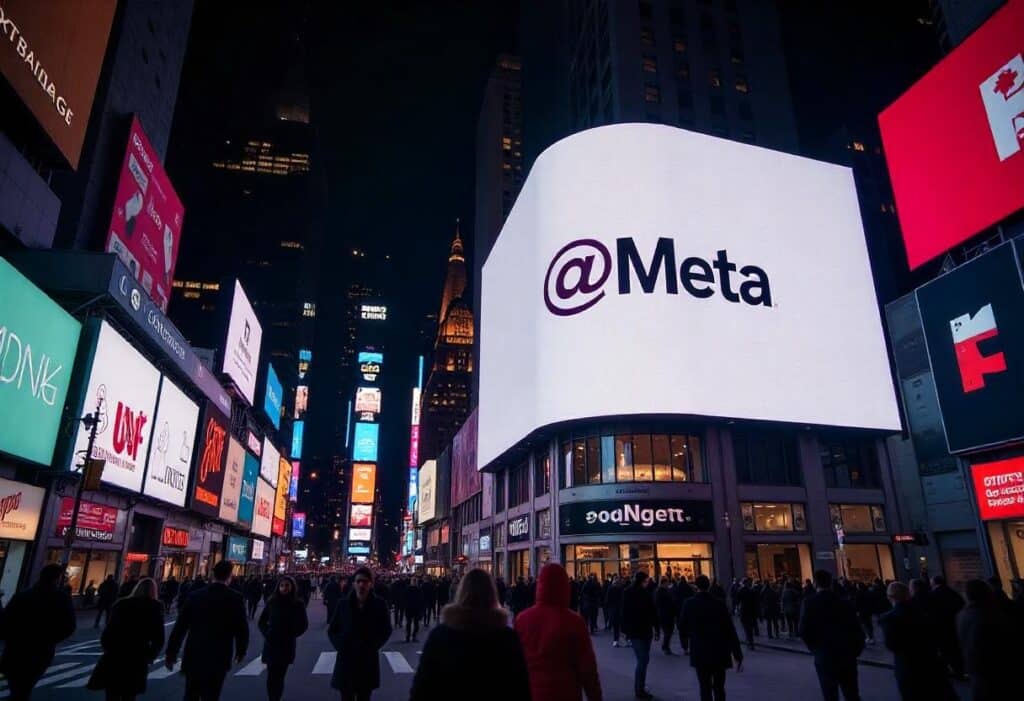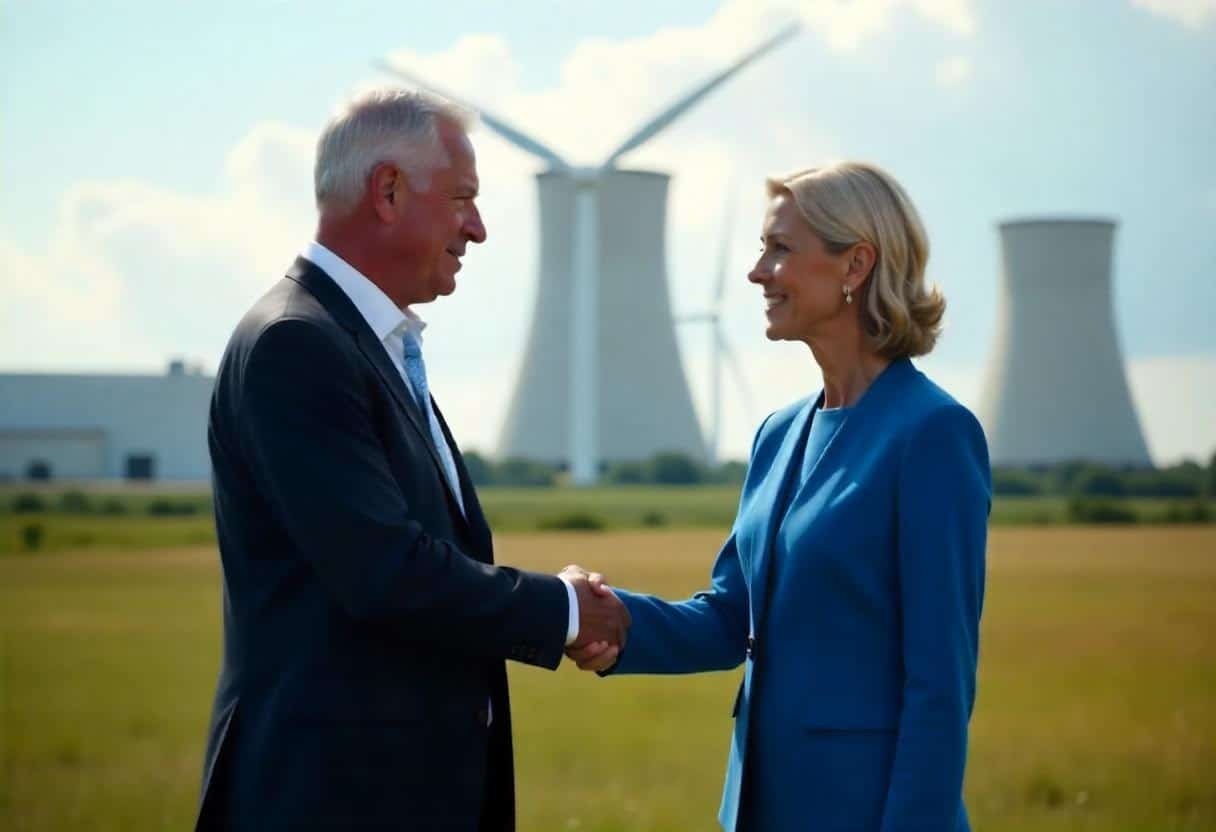In a landmark move to address the surging energy demands of its data centers, Meta Platforms Inc. has signed a 20-year power purchase agreement (PPA) with Constellation Energy Corporation to secure 1,121 megawatts of emissions-free nuclear energy from the Clinton Clean Energy Center in Illinois, starting in June 2027.
This agreement, announced on June 3, 2025, marks Meta’s first significant foray into nuclear energy and underscores a broader trend among tech giants, including Amazon, Google, and Microsoft, to partner with the nuclear industry to power their artificial intelligence (AI) and data center operations. As the global demand for data processing and AI capabilities skyrockets, this strategic partnership not only ensures Meta’s commitment to 100% clean energy but also highlights the pivotal role nuclear power is poised to play in the future of sustainable technology infrastructure.
Below, I’ll explore the details of Meta’s agreement with Constellation, the motivations behind the deal, its implications for the energy and tech sectors, and the broader trend of nuclear energy adoption by hyperscale tech companies.
Additionally, we will delve into the economic and environmental impacts, the challenges facing nuclear energy adoption, and investment opportunities in the burgeoning data center and nuclear energy markets, including recommendations for three financial newsletters that offer insights into related investment opportunities.
The Meta-Constellation Agreement: A Game-Changing Partnership
Details of the Deal
Meta’s 20-year agreement with Constellation Energy secures the entire output of the Clinton Clean Energy Center’s single nuclear reactor, approximately 1.1 gigawatts, starting in 2027. This deal extends the operational life of the Clinton facility, which was at risk of premature closure due to the expiration of Illinois’ ratepayer-funded Zero Emission Credit (ZEC) program in 2027. The agreement also facilitates a 30-megawatt uprate, increasing the plant’s output to 1,121 megawatts, and supports Constellation’s application to renew the plant’s license through 2047 with the U.S. Nuclear Regulatory Commission (NRC).
The Clinton Clean Energy Center, operational since 1987, is one of Constellation’s high-performing nuclear facilities. Without Meta’s backing, the plant faced financial pressures that could have led to its shutdown, mirroring the fate of other nuclear plants in the U.S. that have closed prematurely due to economic challenges. The PPA provides a market-based solution to replace the ZEC program, ensuring the plant’s long-term viability without relying on ratepayer subsidies. The energy will not directly power Meta’s data centers but will flow into the regional grid managed by the Midcontinent Independent System Operator (MISO), supporting Meta’s goal of matching 100% of its electricity use with clean and renewable energy.
Economic and Community Impact
The agreement has significant economic benefits for the Clinton community and beyond. It preserves approximately 1,100 high-paying jobs at the facility and contributes $13.5 million in annual tax revenue. Constellation has also committed to investing $1 million over five years starting in 2026 to support workforce development, education, and local nonprofits in the Clinton area. Bobby Wendell, business manager of IBEW Local 51, highlighted the deal’s importance in delivering a “stable work environment” for workers at the plant. These commitments underscore the broader socioeconomic benefits of sustaining nuclear facilities, particularly in regions dependent on the jobs and revenue they generate.

The Driving Force: Data Centers and AI Energy Demands
The AI Boom and Energy Consumption
The rapid expansion of AI and cloud computing has dramatically increased the energy demands of data centers. According to Goldman Sachs, data centers are projected to consume 8% of total U.S. electricity demand by 2030, up from 3% currently. McKinsey forecasts U.S. data center power consumption to surge from 17 gigawatts in 2022 to 35 gigawatts by 2030, driven by higher-power chips and AI workloads that require racks consuming over 60 kilowatts, compared to 10 kilowatts five years ago. This unprecedented demand is straining electrical grids and prompting tech companies to seek reliable, carbon-free energy sources to meet both operational and sustainability goals.
Meta, as a leader in AI development, is investing heavily in data centers to support its AI-driven platforms, including Facebook, Instagram, and WhatsApp. The company’s commitment to achieving carbon neutrality and matching 100% of its electricity use with clean energy has driven its exploration of nuclear power, which offers reliable, 24/7 carbon-free energy unlike intermittent renewable sources such as solar and wind. Urvi Parekh, Meta’s head of global energy, emphasized the necessity of securing clean, reliable energy to advance the company’s AI ambitions while supporting the long-term operation of existing nuclear plants.
Why Nuclear Power?
Nuclear power is uniquely positioned to meet the energy needs of data centers due to its reliability and low carbon footprint. Unlike solar and wind, which depend on weather conditions and often require fossil fuel backups, nuclear plants can operate continuously, producing emissions-free energy for up to two years without refueling. This reliability is critical for data centers, which require uninterrupted power to support AI workloads and cooling systems. Additionally, nuclear power aligns with the sustainability goals of tech giants, who face increasing pressure to reduce their environmental impact.
The Meta-Constellation deal is part of a broader industry trend. In September 2024, Constellation announced a 20-year PPA with Microsoft to restart Three Mile Island Unit 1, renamed the Crane Clean Energy Center, to supply 835 megawatts of nuclear power for Microsoft’s data centers by 2028. Amazon acquired a data center campus powered by Talen Energy’s Susquehanna nuclear plant in March 2024, and Google partnered with Kairos Power to develop small modular reactors (SMRs) to provide 500 megawatts by 2035. These deals reflect a growing recognition of nuclear energy’s role in powering the AI revolution sustainably.
Broader Implications for the Nuclear and Tech Sectors
Revitalizing the Nuclear Industry
The Meta-Constellation agreement is a significant milestone in the resurgence of nuclear energy in the U.S. After a decade of reactor shutdowns due to high costs and competition from low-cost natural gas, nuclear power is experiencing a renaissance driven by the energy demands of data centers and supportive government policies. In March 2025, Meta, Amazon, and Google joined the World Nuclear Association’s pledge to triple global nuclear energy capacity by 2050, signaling strong industry commitment. President Donald Trump’s executive orders in 2025 aimed at accelerating nuclear deployment, including faster regulatory approvals for SMRs, further bolster this trend.
Constellation, the largest operator of U.S. nuclear power plants with 21 reactors, is capitalizing on this momentum. The company is exploring the development of an SMR at the Clinton site, leveraging the existing infrastructure and Meta’s PPA to justify the investment. SMRs, which are smaller and potentially more cost-effective than traditional reactors, are seen as a promising solution to scale nuclear power. However, no SMRs are currently operational in the U.S., and their deployment faces challenges such as high upfront costs and lengthy regulatory processes.
Challenges and Regulatory Hurdles
Despite the enthusiasm, nuclear energy adoption faces significant challenges. Restarting or extending the life of existing reactors, such as Clinton or Three Mile Island, requires substantial investments in equipment upgrades and rigorous NRC safety and environmental reviews. For instance, Constellation’s plan to restart Three Mile Island involves a $1.6 billion investment and a three-year timeline to secure NRC approval, with operations targeted for 2028. Public perception, particularly around safety concerns stemming from historical incidents like Three Mile Island’s 1979 partial meltdown, remains a hurdle. Anti-nuclear groups, such as Three Mile Island Alert, continue to raise concerns about safety, nuclear waste storage, and potential cost shifts to ratepayers.
Regulatory setbacks also pose risks. In November 2024, the Federal Energy Regulatory Commission (FERC) rejected an amendment to increase power capacity for an Amazon data center connected to Talen Energy’s Susquehanna plant, citing grid reliability concerns and potential cost increases for consumers. Constellation, which supported Talen in this battle, is now seeking clearer FERC guidelines for co-located data centers to prevent similar roadblocks. These regulatory uncertainties could delay or complicate future nuclear-data center partnerships.
Environmental and Grid Reliability Benefits
The Meta-Constellation deal contributes to grid reliability by ensuring the Clinton plant continues to supply emissions-free energy to the MISO grid. Nuclear power’s ability to provide baseload power—consistent electricity regardless of weather conditions—makes it a critical asset as data center demand strains regional grids. The additional 30-megawatt uprate at Clinton will further enhance grid capacity in central and southern Illinois. Environmentally, the agreement supports Meta’s goal of 100% clean energy and reduces reliance on fossil fuel backups, contributing to global decarbonization efforts.
Investment Opportunities in Data Centers and Nuclear Energy
The convergence of AI-driven data center growth and nuclear energy adoption presents significant investment opportunities. As tech companies increasingly rely on nuclear power to meet their energy needs, companies like Constellation Energy are well-positioned to benefit.
Constellation’s stock surged over 15% following the Meta deal announcement and 91.3% in 2024, reflecting strong market confidence in its nuclear strategy. The company’s $16.4 billion acquisition of Calpine Corp in January 2025 and its $1 billion contract to supply nuclear power to 13 federal agencies further underscore its growth potential.
Investors seeking exposure to this trend can explore financial newsletters that provide expert insights into data center and nuclear energy stocks. Below are three recommended newsletters offering free reports on related investment opportunities.
The Near Future Report
Overview: The Near Future Report, authored by Jeff Brown, focuses on emerging technologies and their investment potential. A subscription includes access to the free report The Backbone of Data Centers: Nvidia and Two Other Stocks Set to Dominate AI, which highlights three companies poised to benefit from the AI-driven data center boom. These companies are involved in critical infrastructure, including power solutions and hardware, making them relevant to the nuclear-data center nexus.
Why Subscribe?: The report provides detailed analysis of companies like Nvidia, a leader in AI chips, and two other firms with strong growth potential in data center infrastructure. As nuclear power becomes integral to data centers, understanding the broader ecosystem—including chipmakers, power providers, and cooling system manufacturers—can help investors identify high-return opportunities.
Relevance to Meta’s Deal: The Meta-Constellation agreement highlights the critical role of reliable power in data centers. The Near Future Report’s focus on AI infrastructure stocks aligns with this trend, as companies providing power solutions or supporting data center operations could see increased demand driven by nuclear partnerships.
Overview: Louis Navellier’s Growth Investor newsletter specializes in identifying high-growth stocks with strong fundamentals. A subscription includes access to the free report The Trump AI Boom: 3 Data Center Stocks with Extreme Upside Potential, which focuses on three data center-related companies expected to thrive amid supportive policies and rising AI demand.
Why Subscribe?: Navellier’s report leverages his proprietary stock-rating system to identify companies with significant upside potential in the data center sector. As nuclear energy becomes a preferred power source for hyperscalers, companies involved in data center construction, operation, or energy supply could benefit. The report’s focus on the “Trump AI Boom” reflects optimism about pro-nuclear policies accelerating industry growth.
Relevance to Meta’s Deal: The Clinton deal exemplifies the growing intersection of nuclear energy and data centers. Navellier’s report offers insights into companies that could capitalize on this trend, particularly those benefiting from increased data center investments and favorable regulatory environments.
Porter & Co.’s Parallel Processing Revolution
Overview: Porter & Co.’s Parallel Processing Revolution Stocks: The Final Frontier, led by Porter Stansberry, focuses on the transformative potential of parallel processing technologies driving AI and data center growth. A subscription to The Big Secret on Wall Street includes access to a bundle of reports, including NVIDIA’s Secret Partners, which highlights three lesser-known companies critical to Nvidia’s ecosystem, such as a chip manufacturer, a resource controller, and a chip design firm. The bundle is priced at $199, offering a cost-effective alternative to the full newsletter subscription ($1,425/year).
Why Subscribe?: The report identifies companies integral to the parallel processing revolution, which underpins AI and data center operations. These companies, including one that owns machines for sub-10-nanometer chip production, another controlling 90% of a key GPU resource, and a design firm generating $3 billion in revenue with minimal capital expenditure, offer compelling investment opportunities due to their lower visibility and high growth potential. The emphasis on energy-intensive AI infrastructure aligns with the nuclear energy trend, as data centers require reliable power sources like those provided by Constellation.
Relevance to Meta’s Deal: The Meta-Constellation agreement underscores the energy demands of AI-driven data centers. Stansberry’s report highlights companies that support the technological infrastructure of these data centers, which rely on nuclear power for stable energy. Investing in these “secret partners” could provide exposure to the broader AI and energy ecosystem.
The Future of Nuclear Energy in Tech
Meta’s Broader Nuclear Strategy
Beyond the Constellation deal, Meta is actively pursuing additional nuclear energy projects. In December 2024, the company issued a request for proposals (RFP) to add 1 to 4 gigawatts of new nuclear generation capacity in the U.S. by the early 2030s, focusing on advanced nuclear technologies. Meta has shortlisted projects across multiple states, prioritizing sites with high feasibility and clear timelines. This RFP, separate from the Clinton agreement, aims to catalyze new nuclear development to support future data centers, reinforcing Meta’s leadership in driving nuclear innovation.
Industry-Wide Trends
The Meta-Constellation deal is part of a larger wave of nuclear partnerships. Microsoft’s agreement to restart Three Mile Island, Amazon’s acquisition of a nuclear-powered data center campus, and Google’s SMR initiatives demonstrate the tech industry’s commitment to nuclear energy. Deloitte estimates that new nuclear capacity could meet 10% of the projected increase in data center electricity demand by 2035, through a combination of uprates, reactor restarts, and new deployments. This trend is supported by government initiatives, such as the U.S. Department of Energy’s support for nuclear restarts and the White House’s push for faster SMR approvals.
Challenges to Scale
Scaling nuclear energy for data centers faces several obstacles. High upfront costs, long construction timelines, and regulatory complexities remain significant barriers. The NRC’s review process for reactor restarts or new licenses can take years, as seen with Three Mile Island’s 2028 target. Public opposition, particularly in communities with historical concerns about nuclear safety, could also slow progress. Additionally, the lack of operational SMRs in the U.S. means that widespread adoption may be a decade away, prompting some data center operators to rely on natural gas as a stopgap.
Conclusion
Meta’s 20-year nuclear power agreement with Constellation Energy is a pivotal step in addressing the energy demands of its AI-driven data centers while advancing its sustainability goals. By securing 1,121 megawatts from the Clinton Clean Energy Center, Meta ensures the plant’s long-term operation, supports local jobs, and contributes to grid reliability. This deal reflects a broader industry shift toward nuclear energy, driven by the need for reliable, carbon-free power to support the AI revolution. As tech giants like Amazon, Google, and Microsoft follow suit, nuclear power is poised to play a central role in the future of data centers.
For investors, this trend presents significant opportunities in the nuclear and data center sectors. Newsletters like The Near Future Report, Louis Navellier’s Growth Investor, and Porter & Co.’s Parallel Processing Revolution offer valuable insights into companies poised to benefit from this convergence. By understanding the interplay between AI, data centers, and nuclear energy, investors can position themselves to capitalize on this transformative market shift. As the energy landscape evolves, partnerships like Meta’s with Constellation will shape the future of technology and sustainability for decades to come.
































